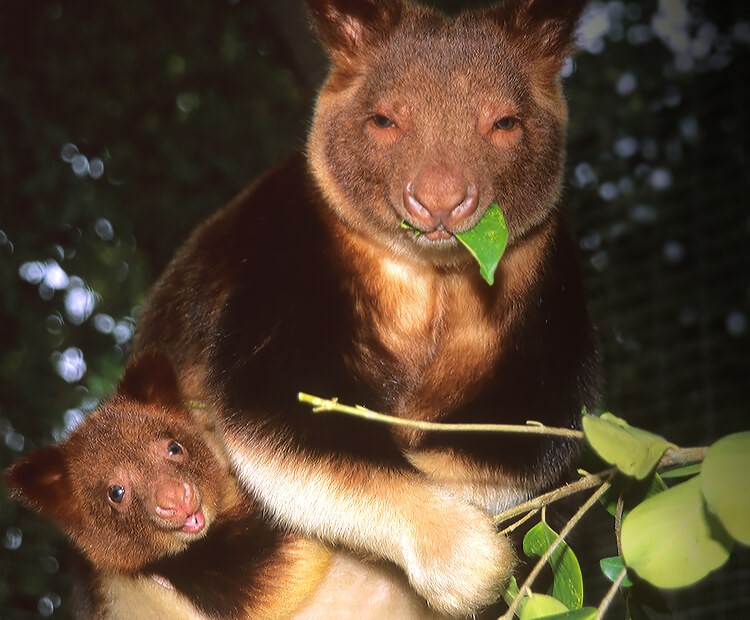Tree Kangaroos really do exist!!

Photo Credit: https://kids.sandiegozoo.org/animals/tree-kangaroo
People come to Australia and Far North Queensland for numerous pleasures, but one of the most common requests we get on tour is to see some of the different wild life this country has to offer. This country is notorious for having some of the strangest wildlife in the world. We are downunder and far removed from the rest of the globe, and yes everything here is unique. We do not have monkeys (we might act like them) or tigers or elephants that are so abundant in the northern hemisphere, but we have our own array of wild life. One of our favourites found in the Wet Tropics is the most humble tree kangaroo.
Tree Kangaroos
Yes, a tree kangaroo. Now most people have heard of the infamous Australian Dropbear, but when we mention a Tree Kangaroo on tour, most people have a dumbfounded look on their face. Even most Australians think you have an overactive imagination. So many people on tour have responded with “Kangaroos can’t live in trees, they’re too big” or “rubbish, you’re making that up”. They do exist, but they are incredibly hard to spot, they are elusive and extremely well camouflaged in the trees. Also they are not found throughout Australia, only in FNQ. This is one of the reasons most Aussies from down south think we are taking the piss out of them. This blog will try and give you some insight into the elusive tree kangaroo and allow you to better understand this very shy creature.
In the Wet Tropics we have two different tree kangaroo species. The Lumholtz tree kangaroo is found in the Tablelands and from what we have seen on tour is easiest to find near Malanda. The other variety is the Bennetts tree kangaroo, we have seen this more commonly found north of the Daintree River and around the surrounds of Cape Tribulation.
Kangaroos are classified under the species, Macropod. Macro meaning big and pod meaning foot. It is believed that kangaroos initially developed from the humble possum at a time when the country was covered in rainforest. Over time Australia’s landscape changed with increased amounts of grassland and Savannah. During this time the majority of macropods moved to the ground in order to forage for food and their lifestyles and diet adapted dramatically. There were however some macropods (the tree kangaroos) who returned back to the tree tops for save haven from predators. However endangered they might be, the Lumholtz and Bennetts tree kangaroos still survive to this day.
In order to move back to living in the trees, the tree kangaroos had to adapt significantly to survive on small branches at large heights. Unlike their land counterparts who hop with both legs in unison, the tree kangaroo had to regain the function of being able to walk to make travelling in trees easier. As ground lovers who hop only forward, roos have limited movement in their ankles but their tree dwelling relatives have much sideways movement in their ankles and wrists to allow them to hold onto branches. They also gained much more strength in their front limbs to help climb, giving them much stronger arms relative to other ground dwelling roos. The change in their limbs is also seen in their large claws to help grasp and grip. Their hind feet are shorter and broader then other roos to give them a much larger centre of gravity, and more balance so they don’t fall from the trees. They also use their tail to help them balance in precarious positions up high.
All of these adaptions have allowed the tree roos to find a heightened home, and they easily roam between the trees. They can supposedly jump metres between branches meaning they spend the majority of their time off the ground. They can find all of their food up in the trees as they survive off mature leaves from a multitude of trees in the region. Staying in the trees is one of the reasons tree kangaroos are so endangered. Since European settlement of the region, there has been a lot of logging throughout the Far North Queensland region, and this has had a massive impact on the amount of space these animals have to call home. Again this shows just how important it is the region is protected from further abuses.
We do sometimes spot tree kangaroos on tour with Barefoot, but they are elusive. The best spots to see the lovely Lumholtz is in the Tablelands near the Fig tree, at Nerada Tea plantation, and walking tracks near Malanda Falls. If you happen to see one during your travels count yourself extremely lucky.
